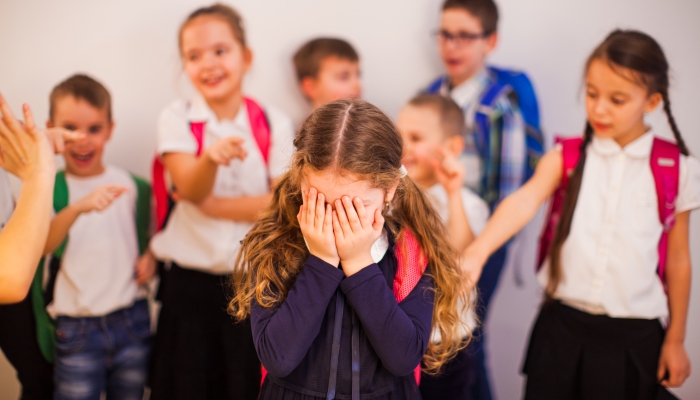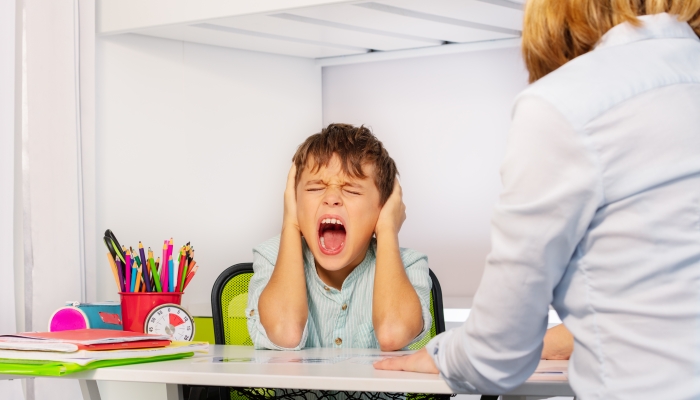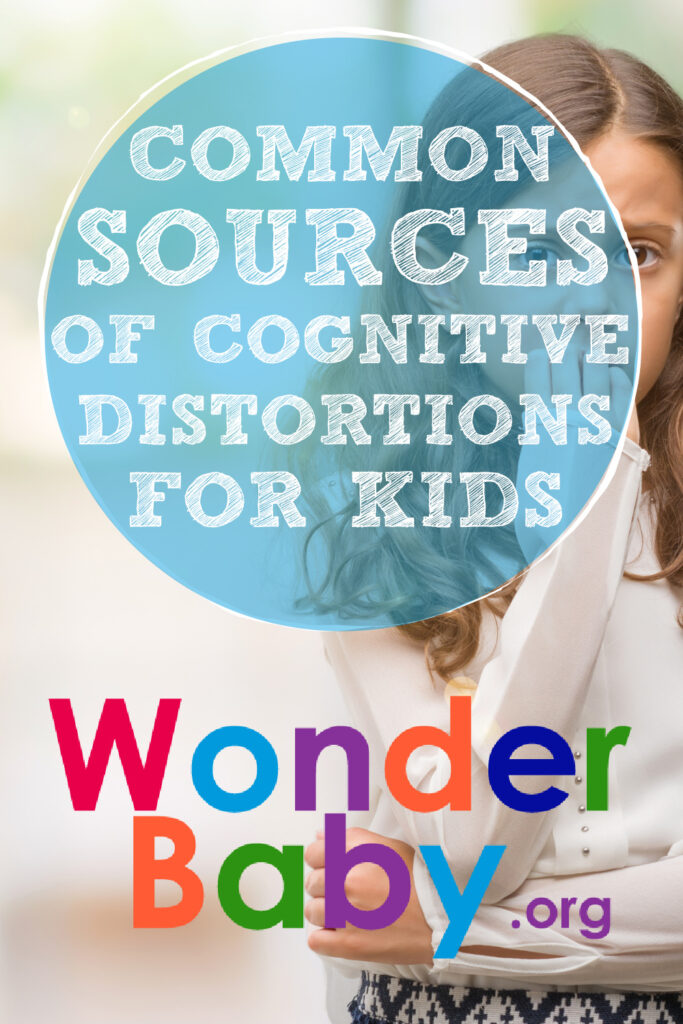Common Sources of Cognitive Distortions for Kids

This post may contain affiliate links; please see our terms of use for details.
- Cognitive distortions are repeated patterns of unrealistic or inaccurate, negative thinking.
- Parents, school counselors, or therapists can help children reduce cognitive distortions.
- Validation, empathy, and offering support are skills that will help reduce thinking errors.
- Cognitive Behavioral Therapy (CBT) is an effective therapy for children and adults.
- If you notice your child has excessive worries or struggles with extreme emotions, it may be beneficial to seek professional help.
Have you noticed your child worrying a lot? What started as a simple thought has now evolved into several grim thoughts.
Some days it may feel like a storm cloud is following your child around.
A few weeks after my daughter started Kindergarten, she walked into her classroom without her lunchbox. When she discovered the mistake, she was beside herself. Her initial thought was, “What if I don’t have lunch today?”
Shortly after, she overheard kids laughing in the classroom and thought, “They’re laughing at me. They think I’m stupid for losing my lunch.” As she walked to the office to get help, she started to cry. Anxiety, fear, embarrassment, and dread overwhelmed her.
As her crying continued, she thought, “Everyone thinks I’m a crybaby. I’m so stupid.” She struggled the rest of her day with gloomy thoughts.
What started as an innocent forgetful moment turned into a stressful day. Her continual negative thoughts increased her anxiety. By the end of the day, she felt miserable.
That day she experienced many cognitive distortions and needed the guidance of an adult to help her.
If you are a parent of a child that has cognitive distortions or worries a lot, it’s normal to have concerns. Learn how to identify cognitive distortions in kids, helpful coping skills that will help reduce them, and when to seek help.
What are Cognitive Distortions?
Cognitive distortions were first introduced by psychologist Aaron Beck in 1963 as a pattern of thinking that contributed to anxiety and depression. Cognitive distortions are repeated patterns of unrealistic or inaccurate, negative thinking.
Cognitive distortions can lead to various mental health disorders such as depression, anxiety, or low self-esteem.
Adults and children struggle with thinking mistakes. A child may have a lot of worries. For children, sometimes therapists will refer to cognitive distortions as “stinkin’ thinkin’.”
A child’s inaccurate, negative thought negatively impacts a child’s feelings and behaviors.
Examples of a cognitive distortion for a child might be:
- “I’m the dumbest kid ever.”
- “I’ll never have any friends.”
- “They are laughing at me, I just know it.”
- “It’s always my fault when things go wrong.”
- “I am always nervous.”

Common Symptoms of Cognitive Distortions in Kids
Negative thinking patterns will influence a child’s emotions and behaviors. You may notice a change in your child’s mood when stinkin’ thinkin’ increases.
When children are struggling with cognitive distortions, you may notice several different behaviors such as:
- thinking in absolutes (always, never)
- jumping to extremes
- acting stubborn
- pessimistic thinking
- exaggerating
- aggression
- dramatic reactions
- an increase in separation anxiety or heightened separation anxiety at night
It may feel like you and your child are on an emotional roller coaster. But it doesn’t have to stay that way. Identifying cognitive distortions in your children and yourself is the first step in helping your child.
Common Types of Cognitive Distortions
Noticing and understanding your own cognitive distortions will bring more insight and awareness to your child’s negative thought patterns.
There are many common types of cognitive distortions. Some of the most common cognitive distortions include:
Black and White Thinking
Black and white thinking is sometimes referred to as all-or-nothing thinking. Black and white thinking means thinking in extremes. Examples of black-and-white thinking include: “If it isn’t perfect I have failed” or “either I do it right or not at all.”
Catastrophizing or Minimizing
Catastrophizing, also called magnification, is blowing things out of proportion. For a child, this may look like, “If I fail this test, I will never pass school, and my life will be a failure.”
Minimizing is the opposite of catastrophizing. It is shrinking something to make it seem less important or downplaying what others think.
Overgeneralizing
Overgeneralizing means creating a conclusion based on a single event or being overly broad in drawing a conclusion. It often involves thinking in absolutes. Examples of thinking in absolutes include words such as:
- all or none
- every
- must
- always or never
- only
For example, overgeneralizing is thinking, “Nothing good ever happens for me.”
Labeling
Labeling is attaching a negative label to ourselves or other people. Examples include, “I am a bad mom,” or “They are so stupid.”
Disqualifying the Positive
Disqualifying the positive means discounting the good things that happen or that you have done. For example, saying “that doesn’t count” or “that was a fluke” when good things happen.
Jumping to Conclusions
Jumping to conclusions involves either mind reading or fortune-telling cognitive distortions. Both of these negative thoughts involve jumping to conclusions with limited information.
Mind reading means assuming we know what others are thinking. An example of mind reading is, “They’re making fun of me. They think I’m stupid,” when a group of children nearby are laughing about something.
Fortune telling involves predicting the future with a negative outcome. An example of fortune telling is thinking, “If I don’t enforce a consequence right now, my child will never be an independent adult.”
Emotional Reasoning
Emotional reasoning is the belief that because we feel a certain way, what we think must be true. For example, “I feel embarrassed; I’m so dumb.”
Personalizing and Blaming
Personalization is taking responsibility or blaming yourself for something that wasn’t your fault. Blaming, on the other hand, is blaming others for something that is your fault. Both types typically involve negative self-talk. An example of personalization is thinking you are intentionally left out of a group when friends are playing together without you.
Pay attention to cognitive distortions in your own thinking. Can you identify common cognitive distortions that you have? The more you recognize your own patterns of cognitive distortions, the better you can teach children to identify their thinking errors.

How to Help Kids Deal with Cognitive Distortions
It is important to help challenge unrealistic thoughts with your child. Helping children recognize cognitive distortions and challenge those thoughts and behaviors can reduce anxiety and depression.
1. Recognize the Negative Thought Pattern
The first step in helping a child deal with cognitive distortions is understanding and recognizing the negative thought pattern. If you’ve noticed your child worrying more, focus on what types of worries they express.
Everyone has negative thoughts occasionally, but if you start to notice a pattern or fixation on negative thoughts, your child might need more help overcoming their distortions. Review the different types of cognitive distortions and see if you can identify a pattern in the types of stinkin’ thinkin’ they are experiencing.
2. Validate and Empathize
When your child expresses a worry that you have identified as a cognitive distortion, start with validation. Show that you hear them by listening and repeating what they say. Do not try to offer logic or reasoning yet. Instead, validate how they are feeling and provide empathy. Try to understand how it might feel to have that thought.
For example, you might say, “That had to be hard,” or “I can imagine how that felt.” Give your child time to share their experience.
3. Offer Support
After you have validated your child and your child feels that you understand, offer support.
When a child is feeling rigid in their thoughts, offer support by saying, “I wonder if there’s another way to look at it.” Engage with your child and see if they are willing to look at their thoughts from different perspectives. Do not try to force your child to see a different perspective. If they are not open to hearing other thoughts, go back to validation and empathy.
Now that you are more familiar with cognitive distortions, teach your child about stinkin’ thinkin’.
- Hardcover Book
- Kilgore, Emily (Author)
- English (Publication Language)
- 40 Pages – 08/25/2020 (Publication Date) – little bee books (Publisher)
Reading books such as The Whatifs by Emily Kilgore or Way Past Worried by Hallee Adelman can also help children better understand their distorted thinking.
Encourage children to use art to express themselves. When a child is stuck on a distortion, have them draw a picture of a positive alternative. Or encourage your child to imagine a time in their life that was good. A time they felt safe, proud, or happy. Have them draw that moment. Then, encourage your child to visualize the positive picture any time an anxious thought arrives.
With younger children, introduce alternative thoughts in a playful way. Through role-play with puppets or stuffed animals, reenact scenarios where the animals are challenging thinking errors.
- Hardcover Book
- Adelman, Hallee (Author)
- English (Publication Language)
- 32 Pages – 10/01/2020 (Publication Date) – Albert Whitman & Company (Publisher)
4. Don’t Try to Change How They Feel
Do not try to change or deny how your child feels. The goal is to challenge the thought, not the feeling. If you find your child pushing back or taking an extreme position, return to validation and empathy.
Your child needs to feel validated and heard. You do not need to change or fix how they feel but instead focus on challenging the thoughts behind the emotion.

What is Cognitive Behavioral Therapy?
Cognitive behavioral therapy (CBT) is a common type of talk therapy originally introduced by psychologist Aaron Beck. Several research studies show it is considered an effective method to help treat anxiety, depression, and other mental health concerns.
CBT helps individuals manage problems by changing the way they think and changing behaviors. CBT focuses on creating coping skills to challenge unhelpful thinking patterns that influence emotions and behaviors.
Is Cognitive Behavioral Therapy Effective for Kids?
CBT is an effective therapy for children when parents also learn CBT techniques and coping skills to help guide them. According to a 2010 study by Minde et al., the effectiveness of CBT in young children increases with parental involvement and support at home.
- Dawn Huebner (Author)
- English (Publication Language)
- 80 Pages – 09/15/2005 (Publication Date) – Magination Press (Publisher)
For children and parents, a workbook such as What To Do When You Worry Too Much by Dawn Huebner, Ph.D., can also help. In this workbook, Dr. Huebner compares continuously focusing on worries (or cognitive distortions) to tending to a tomato plant. The more attention you give a tomato plant, the more tomatoes it grows. It’s the same with worries: The more attention you give worries, the more worries grow. In the workbook, children are given a step-by-step guide utilizing standard CBT techniques on understanding worries and different tools to help stop focusing on them.
When to Seek Professional Help
If you notice your child is having excessive worries or still struggles with extreme emotions after implementing some of the skills above, it may be beneficial to seek professional help.
If your child is in school, reach out to your child’s school counselor. Many school counselors have social-emotional learning curricula available to assist students. Discuss the possibility of increasing social and emotional learning in school to help increase self-esteem and critical thinking skills that can challenge negative thoughts.
If you find yourself accommodating your child’s anxiety by avoiding people, places, or things, it is important to seek help from a mental health professional. Mental health professionals, such as play therapists, are trained in different cognitive therapy techniques, such as CBT, to help children challenge negative automatic thoughts.
Cognitive distortions will come and go. With support from you or a professional, your child can adapt healthy coping skills to overcome their stinkin’ thinkin’.

The information WonderBaby provides is not intended to be, and does not constitute, medical or other health advice or diagnosis and should not be used as such. Always consult with a qualified medical professional about your specific circumstances.
Related Posts

Behavior
Understanding Intermittent Explosive Disorder in Children
Are you worried about your child’s unexpected aggression and explosive behaviors? Learn how to support a child with intermittent explosive disorder.

Behavior
5 Emotional Regulation Activities for Kids
Want to teach your child how to regulate emotions? Here are emotional regulation activities for kids that can help!

Behavior, Special Needs
5 Tips for Dining Out with Children Who Have Sensory Sensitivities
Worried about dining out with sensory sensitivities? Try these tips for less stress and more fun the next time you take your family out to eat.


